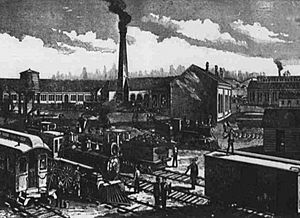Albina, Portland, Oregon facts for kids
Albina is a collection of neighborhoods located in the North and Northeast parts of Portland, Oregon, United States. For most of the 20th century, it was home to the majority of the city’s African American population. The area gets its name from Albina, Oregon, a historic American city that became part of Portland in 1891. Albina includes the modern Portland neighborhoods of Eliot, Boise, Humboldt, Overlook, and Piedmont.
Contents
A Look Back at Albina's History
Historic Albina was once a "company town." This means it was largely controlled by a single company, in this case, the Union Pacific Railroad. It joined the city of Portland in 1891.
In the 1870s and 1880s, many of Albina's first residents were new immigrants from Europe. They often worked for the Union Pacific Railroad or on the docks.
How Albina Became a Home for African Americans
By 1910, many African American families in Northwest Portland found their neighborhoods were too crowded. They started looking for homes across the river in Lower Albina. This area was close to jobs at the docks and with the railroad.
However, new neighborhoods in East Portland had rules that made it difficult for African American families to buy homes there. These rules meant that most African American families looking for homes in East Portland were limited to the Albina area.
Even with these challenges, homes in Albina were often affordable. This made it possible for many African American families to own their first homes. The area also had good transportation, and men could find jobs working for the railroad.
World War II and Growing Communities
Albina's community grew slowly until World War II. During the war, many workers were needed to support the war effort. A large number of African American workers came to Portland to work in big shipbuilding yards along the Columbia and Willamette Rivers.
This sudden increase in workers led to a housing shortage. African American workers faced extra challenges because of discrimination when trying to find places to live.
Vanport and Its Impact
In 1942, a large housing area called Vanport was built in North Portland. It was created to house the many shipyard workers.
However, in 1948, a big flood from the Columbia River destroyed Vanport. Over 16,000 people lost their homes. Many African American residents who were displaced had limited housing choices. A lot of them moved back to Albina, renting older homes or apartments that white Portlanders had left when they moved to the suburbs.
After World War II
Between 1940 and 1960, the African American population in Albina grew a lot. At the same time, more than 21,000 white residents moved out to the suburbs or other parts of Portland.
By 1960, African Americans made up only 2% of Portland's total population. But, 80% of them lived in the Albina neighborhood. Because of this, there were very few African American voices in the city government or other important community groups.
Changes and Challenges in Albina
In the early 1950s, residents of Albina opened their own shops, restaurants, and clubs. These businesses served the growing black community.
However, from the mid-1950s through the early 1960s, many residents lived in homes that were not in good condition. Ideas for improving the area were often turned down. It became very hard for residents to get money to fix or buy homes. This led to many homes being abandoned. It was difficult for Black residents to own homes, even when they were affordable.
Freeway Construction and Community Struggles
In the 1960s, the construction of the Interstate-5 freeway cut right through neighborhoods in Albina. This forced many residents and local businesses to move.
The area continued to face difficulties. Programs meant to help the area, like the Model Cities Program, had limited success. The expansion of Emanuel Hospital also caused more economic problems. Residents still struggled to get loans to buy homes, and community tensions increased.
The neighborhood was also the site of a difficult event known as the Albina Riot of 1967.
Albina Today
Today, community members continue to work together to improve Albina. One recent effort is the Albina Vision Trust. This project aims to build affordable housing and restore land in North and Northeast Portland.


